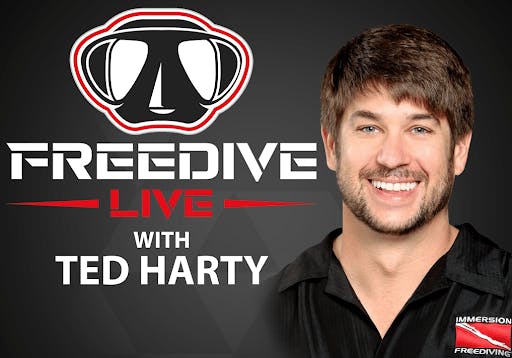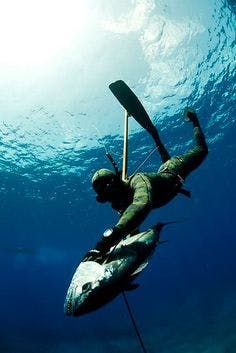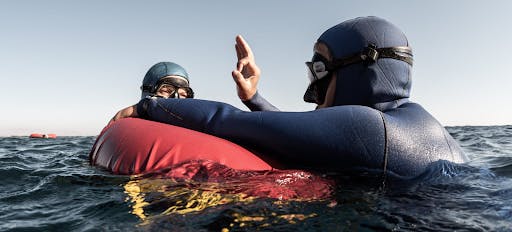Ted Harty Talks: Overweighting While Freediving

Are you wearing too much weight when freediving and spearfishing? Probably so!
My name is Ted Harty and I’m the founder of Immersion Freediving and my new podcast, Freedive Live. I started as a scuba instructor in the Keys in 2005, took my first freediving class with Performance Freediving International in 2009, and then became obsessed with freediving.
I’m a PFI Instructor Trainer, my deepest dive is 279 ft, my longest breath hold is 7 minutes, and I am a past USA Freediving Record holder.

During my freediving classes, I’d estimate that 90% of the students coming into my class are wearing an unsafe amount of weight. Most of my students have been freediving and spearfishing for years. I had one spearfishing student who was wearing 12 pounds on his belt and only needed 2 pounds!
To get started, let’s address why so many freedivers and spearos wear so much weight. It’s easy for me to understand because when I started, I wore way too much weight myself.
When I first started freediving in 2005, I was a diving instructor working at Tildens Scuba Center in Marathon, Florida.
I was spending so much energy getting to the bottom that I was winded by the time I got there. So clearly, the solution is simple, I needed to add more weight.
I would put on a nylon belt and put two 8-pounders on my belt, and I wasn’t even wearing a wetsuit most of the time!
Now I could easily get to the bottom. I’d just take a breath, point my head down, and down I went. It took no energy to go to the bottom, so I thought I was being super smart. I seem to remember thinking about all the weight I was wearing but I told myself I was a dive instructor, I dive every day, I’ve got big super strong diving legs so it’s not a problem. I didn’t have any issues getting to the surface. Ignorance was bliss.
I think many new freedivers have similar thoughts: it’s hard to get to the bottom, your fins are splashing all over the place, you see your friends get down there so easily and effortlessly, the solution is so obvious—you just need more lead!
Overweighting is a crutch for poor technique. Assuming you can equalize your ears, anyone can get to the bottom if they overweight themselves. No skill required.
During my freediving classes, that is exactly why I spend so much time focusing on proper kicking technique, cleaning up your entry, and streamlining. This allows you to easily get to the bottom and get there wearing less weight. A win-win.
Enter Shallow Water Blackout
Shallow water blackout is the #1 killer in freediving and spearfishing. In most cases, the fatalities due to blackouts all occur in the same way. The diver hits the surface, takes 2 or 3 breaths, blacks out, and then sinks to the bottom of the ocean, eventually taking terminal gasps, and dies.
These fatalities are caused by two things happening at the same time: there is no buddy waiting at the surface who is trained in freediving rescue techniques, and the diver is wearing too much weight.
If you have not taken a freediving class, it’s very likely you don’t know how to recognize the signs of an upcoming blackout, or how to revive someone from a blackout. The best way to learn these skills is through an in-person freediving course. The next best thing is to go through my free online safety class www.FreedivingSafety.com where you will learn how to recognize the signs of loss of motor control and blackout, and most importantly, how to save your friend’s life if they have a blackout.
Let's look at why so many freedivers sink when they blackout.
When a freediver has a blackout, one of the first things that happens is the diver releases a large amount of the air in their lungs. How much? I can show you right now.

Take a big breath in, and then do a relaxed exhale like a sigh. That's exactly how much air you would let out if you blackout. You wouldn’t blow out every single bit of air in your lungs as that’s an active process. When you are blacked out you are not doing anything active.
When you let out this much air, you will lose a lot of your buoyancy. This is why most freedivers, especially freediving spearos, sink to the bottom when they blackout.
When you blackout, you will either float on the surface or sink to the bottom of the ocean. This is determined by the amount of lead on your belt. Where would you rather end up if you had a blackout? On the surface? Or on the bottom of the ocean? I think the answer is obvious. The surface! So now the question is, how can you tell if the weight you are wearing is too much? It’s very easy to find out.
Surface Safety Test
This test will easily tell you if you would sink to the bottom of the ocean if you had a blackout.
Jump in the pool or ocean wearing whatever weights you normally wear. Take a big breath, and do a relaxed exhale like a sigh, just how I showed you earlier in the video. At that point, don’t move your feet, don’t move your hands, and see what happens.
If you continuously sink, then you would end up at the bottom of the ocean if you had a blackout. If that happens, take a pound off your belt and repeat the test. Keep taking off a pound at a time until you can do a relaxed exhale at the surface, and no longer continually sink.

That is why other instructors and I recommend wearing one- and two-pounders so you can easily adjust your weight. If you are wearing two four-pounders you can’t take off one pound.
You may have heard things like, be neutrally buoyant at 33 ft, or be positively buoyant on a relaxed exhale at 15 ft. I do similar tests during my freediving class, but I find these tests EXTREMELY hard to replicate outside of a freediving class. That is why I’m such an advocate of the surface safety test. It’s simple, fast, and easy to do.
I discuss more advanced weighting techniques, and cover what I consider to be the gold standard in weight test during my podcast episode on weighting. You can listen directly here: Freedive Live, or search for Freedive Live on your favorite podcast service.
Wearing too much weight reduces your bottom time

First off, when you wear too much weight it makes it easy to go down and hard to go up. When you are wearing the correct amount of weight, it’s hard to go down but easy to go up.
The total amount of work is the same either way, it’s just a matter of where you put the work, at the beginning of the dive or the end of the dive.
Rule of 9's
So, the question is, where does it make sense to put the work?
90% of blackouts happen at the surface after 2 or 3 breaths, 9% of the blackouts happen between 15 ft and the surface, and 0.9% of the blackouts happen between 82 ft and the surface. These deep blackouts almost exclusively happen to deep competitive freedivers (200 ft plus) and are extremely rare.
So, 99% of the blackouts happen between 15 ft and the surface. Does it make sense to weight yourself so that you are doing more work as you go through this danger zone? By weighting yourself the right way, you get an elevator ride to the surface, which is quite nice I think!
Earlier I said the amount of work overall is the same, it’s just a matter of where you experience the work. But there is more to it.
Years ago, I took a spearfishing class with Daryl Wong and Sheri Daye in conjunction with PFI. It was awesome.
During the class I did an experiment. I purposely overweighted myself like a typical spearo. I added about 5-6 extra pounds if I remember correctly. I was diving in the 70ft range.
Here is what happened:
I started my dive to 70 ft and it was awesome! It was so easy. I felt like I barely had to kick at all, I got pulled down to the bottom. Once I got to the bottom I started traveling along the bottom. Right off the bat I was kicking the sand and the rocks. Because I was so overweighted, I had to kick upwards as well to keep from smashing into the rocks, I was not used to this. Eventually I got it sorted and was cruising along the bottom. I didn’t see anything and headed up.
On the way up I noticed something immediately. My legs were feeling a bit of lactic acid burn, nothing crazy, but I never feel lactic burn coming up from these depths. At the time, I was a 200 ft+ freediver so 70 ft was easy, but I was shocked to feel that much work coming up from 70 ft. I kept diving this way and I noticed my bottom time was reduced by around 1/3 of my normal time.
I was honestly shocked. I didn’t think it would make that much of a difference, especially considering, as I keep saying, the work is the same, it’s just a matter of where you put the work.
Here is why I believe overweighting decreases your bottom time. When I was at the surface, because I was so overweighted, I had to spend some amount of extra energy just to keep my snorkel above the waterline. When I’m weighted the right way, the surface is a zone of rest. I can focus on just breathing up. I float like a cork. When I was overweighted, I had to spend some energy just to keep my snorkel above the water. This increased my heart rate, which in turn reduced my bottom time.
This is why I believe being overweighted is not only incredibly dangerous, it also reduces your dive times.
Take a look at competitive freedivers. We, as a group, are singularly focused on diving as deep as possible during competitions. If there was any advantage to overweighting, competitive freedivers would overweight themselves, but we don’t because it’s a disadvantage to our freediving.
My suggestion is, don’t be overweighted! I teach my students to perform the surface safety test every single time they jump off the boat and make sure they are not sinking on exhalation. It takes about 5 seconds. The reason you should do it every time is because there are so many variables. Anytime you are wearing a different suit, or maybe just the top and not the bottoms, or maybe you gained or lost weight, or maybe you are in the springs not the ocean; all these variables change the amount of weight you need.

I would also suggest taking a freediving class so you can get the hands-on skills to learn how to rescue your buddy if they had a blackout, or at a minimum, at least go through my free online safety course @ www.FreedivingSafety.com as you are getting ready to take you in-person freediving course.
Dive safe out there, it’s not even that hard!
Ted Harty - your trusted online freediving resource.
You can listen to my podcast @ https://freedivelive.simplecast.com
You can follow me on Instagram @ www.Instagram.com/ImmersionFD
Freediving FAQs
What is freediving?
Freediving, also known as breath-hold diving, is a form of underwater diving that relies on a diver's ability to hold their breath until resurfacing, rather than using breathing apparatus such as scuba gear. It is practiced both as a recreational sport and in competitive settings.
How long can freedivers hold their breath?
The breath-hold duration varies widely among freedivers, ranging from a minute or two for beginners to over ten minutes for elite competitors. The current world record for static apnea (holding breath without swimming) is over 11 minutes.
Is freediving safe?
Freediving can be safe when practiced with proper training, knowledge, and safety measures. Key safety practices include never diving alone, understanding the body's limits, using proper breathing techniques, and having a trained buddy nearby. Risks include shallow water blackout and hypoxia, so safety protocols are essential.
What equipment is used in freediving?
Basic freediving equipment includes a mask, snorkel, fins, and a wetsuit if diving in colder waters. Some freedivers also use weight belts to help with buoyancy control. Advanced divers may use monofins, nose clips, and lanyards for competitive diving.
How do you train for freediving?
Freediving training involves a mix of physical conditioning, breath-hold exercises, and technique refinement. Key components include practicing static and dynamic apnea, improving lung capacity and diaphragm flexibility, maintaining overall physical fitness, and learning relaxation and mental focus techniques.
How can I start freediving?
To start freediving, it's recommended to take a course from a certified instructor or freediving school. Basic courses cover safety, breathing techniques, equalization, and in-water practice. Joining a local freediving club or community can also provide support and guidance as you begin your freediving journey.





